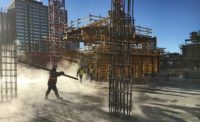Overlooking the massive jobsite at 1 World Trade Center in Lower Manhattan, Dan Tishman, dressed immaculately in a navy blue suit with a red and pink striped tie, stands watching the 300-plus construction workers scurrying around below him.



He shakes his head.
“Sometimes I think I shouldn’t be the guy up here,” Tishman, chairman and CEO of Tishman Construction Corporation, says with a smile. “I’m out here looking down at this site and I’d love to be down there building the scaffolding, pouring the concrete. I was always a big Lego guy as a kid. I guess I’ve always just loved building.”
Everyone at Tishman Construction seemed to share that passion in 2008 as the family-owned firm enjoyed one of the biggest – and busiest – years in its 111-year history. It amounted to rising above grade on the 2.6-million-sq-ft Freedom Tower, tallying a market-leading $2.8 billion in work regionally, and dominating the skyline to manage more than 80% of Manhattan’s commercial high-rise projects. The year also saw the company steering ahead of the looming private development drought by diversifying into public works, small projects, countercyclical sectors, and strategic locations nationally and abroad.
“They have been very smart in how they’ve executed their business plan,” says Louis J. Colletti, president and CEO of the Building Trades Employers’ Association, a New York City-based organization that represents contractors – an association in which Tishman has been extremely active. “They’ve just had an outstanding reputation over a long, long period of time and they’ve built a lot of really strong relationships. That’s culminated in the tremendous success they’ve had over these last couple of years.”
The seeds for this noteworthy year are sprinkled throughout Tishman’s long history. One example is its appetite for innovation, illustrated in its embrace decades ago of construction management as a specialty. There is also the firm’s private, locally controlled, and family-owned status – an advantage today when public owners face harsh market pressures, say Tishman’s leaders. And the company can trace many notable assignments back to carefully cultivated client relationships built over years.
But the recipe requires balancing loyalty to principles that have taken it this far with strategic nimbleness, says Dan Tishman. “It’s very important not to become stagnant as a company,” he adds.
One example is the recent decision to hire Pete Marchetto, who last year left his post as CEO of Bovis Lend Lease, one of Tishman’s strongest local rivals in New York. Some contractors – even ones without a family at its nucleus – would be loathe to add such a senior personality, but Tishman says hearing new perspectives is invaluable. “I’ve seen too many companies over the last 20 years of my career that just do the same thing the same way, year after year, and they just sort of slowly peter out,” he adds. “[W]e continually look for ways to reinvent ourselves.”
Tishman Construction has another distinguishing trait – an internal development arm through its Tishman Hotel & Realty affiliate, headed by John Vickers as chairman and CEO. The construction arm builds the development unit’s projects, notably the E Walk entertainment complex and Westin New York at Times Square. It now is building the 22-story InterContinental New York Times Square hotel on West 44th Street.
“It’s just a tremendous advantage that other construction companies don’t have, and it’s a tremendous advantage that other real estate companies don’t have,”
Vickers says. “And I think we do a great job of blending the two.”




Post a comment to this article
Report Abusive Comment